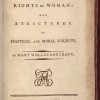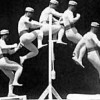
Anne Mellor, “On the Publication of Mary Wollstonecraft’s A Vindication of the Rights of Woman“
Mary Wollstonecraft’s Vindication of the Rights of Woman (1792) laid out the tenets of what today we call ‘equality’ or ‘liberal’ feminist theory. She further promoted a new model of the nation grounded on a family politics produced by egalitarian marriages.

Garrett Stewart, “Curtain Up on Victorian Popular Cinema; Or, The Critical Theater of the Animatograph”
Hard on the heels of the Lumière “Cinématographe” in its Paris debut, the West End appearance of its most successful British equivalent, Robert W. Paul’s “Animatograph,” brought the apparatus for moving-image projection before a British public that would soon flock to its display of miscellaneous short films in theatrical venues all across England, propelling a widespread Victorian fascination with the new medium of visual spectacle and eventual (edited) storytelling, the latter in narrative formats by turns comic, melodramatic, and fantastic. In these emergent genre bearings alone, here was an entertainment technology that looked back into the earlier Victorian period as well as forward to both popular and experimental modernism. Much recent commentary has aimed at connecting this next-century destiny not just to the medium’s Victorian technological origins but to cultural orientations—and literary prototypes—in nineteenth-century habits of attention and imagination.
